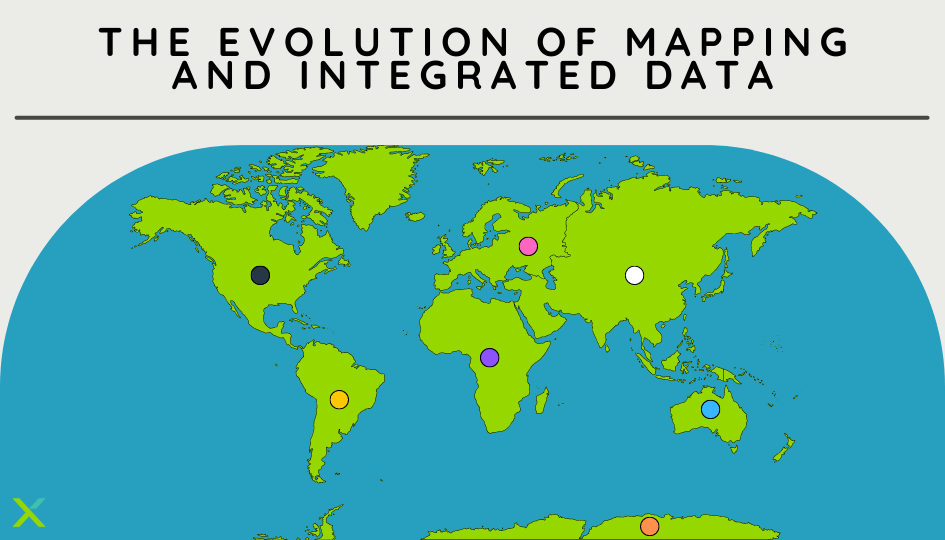
Introduction
Geospatial data has been collected and used for centuries, but today it’s more powerful – and more valuable – than ever before. In the utility industry and beyond, organizations are using geospatial data to innovate and make their workflows more efficient. They’re collecting data that’s helping them save time in the field, avoid unnecessary work, build more powerful geospatial mapping tools, prepare for big changes in the workforce, and more.
While geospatial data is necessary for all these innovations, none of them would be possible without the use of data integration tools to keep that data synchronized, organized, and healthy between systems. Let’s look at how geospatial data has evolved over time and why it becomes more powerful when integration comes into play.
The Evolution of Mapping
Geospatial data is not a new tool; people have been collecting it and making maps for thousands of years. According to the University of Utah, some of the earliest examples of maps were cave drawings outlining hunting plans, travel routes, and even stars in the night sky. Those maps included the earliest examples of geospatial elements like lines, points, and polygons, all of which are still staples of modern maps. Later maps moved from cave walls to parchment and were used for land and nautical navigation, allowing people to accurately navigate new places with more accuracy than ever before.
Some of the biggest developments in mapping arrived in the 20th century; aerial photography and satellite imagery – still the most reliable ways to observe our world from above – were used for mapping for the first time. Later, Roger Tomlinson’s invention of GIS paved the way for computerized mapping to become standard practice; the use of computers allowed geospatial elements to be digitally superimposed on base maps and made sharing geospatial data much easier.
What Mapping Looks Like Today
Today, GIS is still the dominant technology used for mapping our world. Programs like ArcGIS can capture, create, store, and organize geospatial data for mapping terrain, weather, populations, and many more kinds of data. They are also commonly used in conjunction with other data management tools like CIS or EAM systems to create maps using data from multiple sources. These systems even utilize basic features that the earliest mapmakers invented. Geospatial elements like lines, points, and polygons are trademark tools that every GIS-based map relies on, and they were invented thousands of years ago. The main difference now is the number of ways we can use that data.
Modern Uses for Geospatial Data
Thanks to GIS, we now have the ability to present geospatial data in myriad ways, visualize 3D elements, and organize information inside databases that are interactive, configurable, and capable of storing immense amounts of geospatial data. Here’s a few modern examples of geospatial data being utilized to enable amazing workflows:
How Integrated Data Makes It All Possible
All these examples rely on mountains of geospatial data from many different sources, but none of them would be possible without one vital tool: data integration.
As the amount of geospatial data being collected continues to increase at an exponential rate, new ways of storing and organizing that data have become necessary. It’s no longer feasible to store data in siloed systems when the mapping tools we rely on need data from so many sources. The Geonexus Integration Platform can integrate data from systems like ArcGIS, SAP, IBM Maximo, and more, allowing your organization to build incredible tools that depend on geospatial data from multiple systems.
The Geonexus Integration Platform is easy to learn, highly customizable, and is designed to handle data sets both large and small. It’s capable of automatic data synchronization and proactively notifies you anytime an error in your data is detected. It also produces nightly reports that monitor your data’s health in an easy-to-read PDF or XML format. When thousands or even millions of users are depending on tools that utilize data from several systems, isolating and preventing errors is paramount; our platform greatly simplifies the process.
Using integrated geospatial data, mapping tools can improve the everyday lives of people all around the world. The Geonexus Integration Platform provides an integration solution that’s capable of handling the vast amounts of data needed to make those tools come to life.
About Geonexus
At Geonexus our mission is to ensure integrity and reliability of enterprise data to support effective decision making. Our Integration Platform is an enterprise-grade integration solution that is easy to use, reliable, and includes out-of-the-box connectors for Esri® ArcGIS®, IBM® Maximo, SAP®, ABB® Ellipse, Oracle® Utilities, and other leading enterprise systems. Asset-intensive organizations across the globe use the Geonexus Integration Platform in industries including utilities, telecommunications, pipeline, transportation, and government.